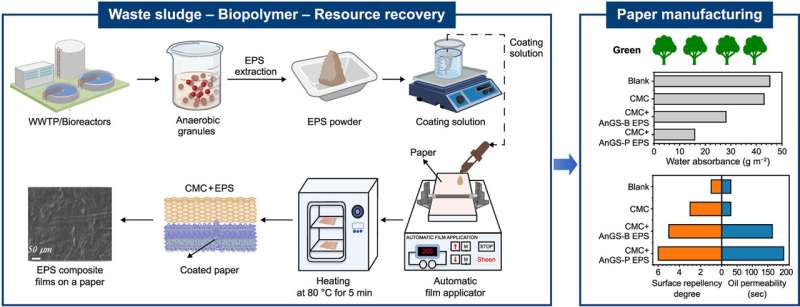This article has been reviewed according to Science X's editorial process and policies. Editors have highlighted the following attributes while ensuring the content's credibility:
fact-checked
proofread
Paper coating biomaterials derived from anaerobic granular sludge may be cost-effective

The demand for paper and paperboard production continuously grows worldwide, particularly in the packaging industry. Due to the paper's nature, it usually requires a surface coating to keep out water, oil, and other unwanted substances. These coatings can come with high financial and environmental costs. Using renewable coating materials that are also cost-effective can support sustainability strategies.
A promising new technique using extracellular polymeric substances (EPS) recovered from anaerobic granular sludge may offer a cost-effective, sustainable approach for transforming wastewater into industrially valuable products and help to reduce carbon emissions.
In a study published in Environmental Science and Ecotechnology, researchers coated paper using EPS extracted from various anaerobic granules in wastewater. This approach enhanced waterproofing (65%), as well as oil and grease resistance, while the multi-layered microstructure of the coated paper exhibited a smoother and less porous surface overall. Extracellular proteins, abundant in β-sheets and random coils, play a pivotal structural role in paper coating.
Biological treatment based on activated sludge has been the most widely used approach in removing major pollutants from wastewater. However, excess sludge disposal accounts for up to 50% of wastewater treatment costs and presents a significant challenge in wastewater treatment.
Wastewater treatment plants are shifting to recovering raw materials, turning these into potential renewable sources. Excess sludge, rich in EPS, is becoming increasingly attractive and contributes to implementing the "biorefinery" paradigm from wastewater treatment plants. EPS-based biomaterials are potential alternatives to synthetic polymers in various applications, such as agriculture, medical, and construction industries, as they have polysaccharides, proteins, and humic-acid substances.
In this study, anaerobic granules were collected from a brewery wastewater treatment plant and a paper-industry wastewater treatment plant. Regardless of the different sludge sources, EPS from both types was mainly composed of proteins. EEM spectra confirmed that tryptophan or protein-like components were the dominant substances, together with humic-like components.
The addition of EPS resulted in improved water/grease-proofing behavior. The best results were achieved with the EPS samples from paper-industry sludge, characterized by a higher fraction of proteins and hydrophobic contents than the other EPS samples. Moreover, the extracellular proteins rich in β-sheets and random coil would facilitate a structural role for paper coating.
This research establishes for the first time that EPS derived from anaerobic granules exhibits interesting water barrier properties when used as paper coating additives. More importantly, from the paper industry's perspective, these EPS enhance resistance to grease penetration and absorbance. These biomaterials recovered from waste granular sludge provide a sustainable resource for industrial application and promise to realize a sustainable and circular economy.
More information: Cuijie Feng et al, Extracellular polymeric substances as paper coating biomaterials derived from anaerobic granular sludge, Environmental Science and Ecotechnology (2024). DOI: 10.1016/j.ese.2024.100397
Provided by Eurasia Academic Publishing Group




















